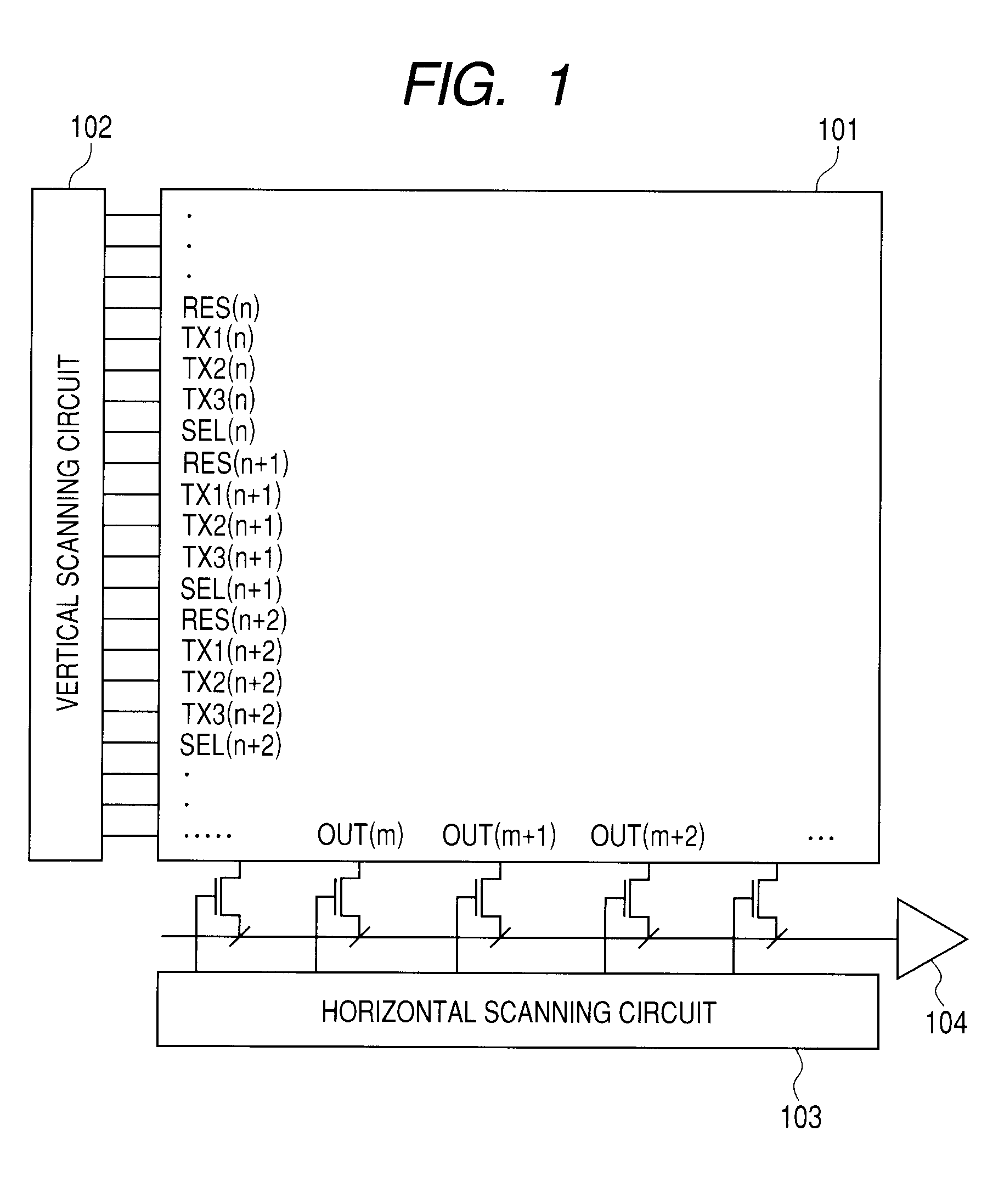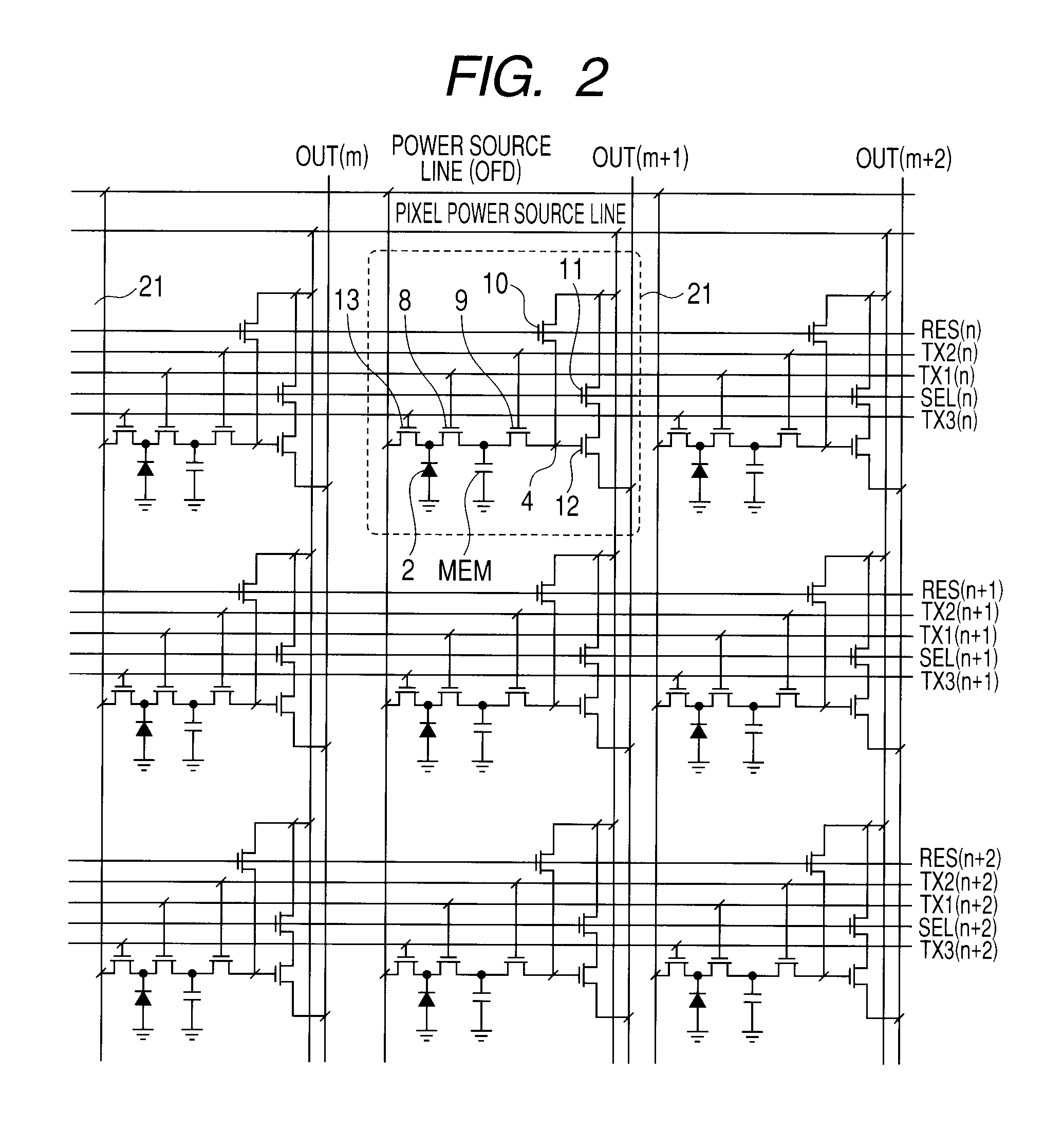Solid-state imaging apparatus, driving method of the same and imaging system
a driving method and imaging system technology, applied in the direction of television system, radioation control device, instruments, etc., can solve the problems of cross talk or color mixture or photo response non-uniformity (prnu), increased dark current, and increased probability of escaping generated electric charg
- Summary
- Abstract
- Description
- Claims
- Application Information
AI Technical Summary
Problems solved by technology
Method used
Image
Examples
first embodiment
[0027]FIG. 1 is a schematic block diagram illustrating a configuration example of a solid-state imaging apparatus according to a first embodiment of the present invention. FIG. 2 is an equivalent circuit diagram of a pixel contained in an imaging area 101. FIG. 3 is a sectional view illustrating a case where a pixel illustrated in FIG. 2 is formed on a semiconductor substrate. FIG. 4 is a timing chart illustrating a driving method of driving the solid-state imaging apparatus.
[0028]In FIG. 1, the solid-state imaging apparatus includes an imaging area 101 in which a plurality of pixels is provided, a vertical scanning circuit 102 which is a control element and a horizontal scanning circuit 103. Here, the pixels provided in the imaging area 101 are assumed to be arranged in a matrix shape. The horizontal scanning circuit 103 sequentially scans signal lines each corresponding to a pixel column of the imaging area 101 and causes an output circuit 104 to output a signal for each of a row ...
second embodiment
[0067]Hereinafter, the driving method of driving the solid-state imaging apparatus according to a second embodiment of the present invention will be described in detail by referring to the accompanying drawings. The second embodiment is the same as the first embodiment except that the first transfer element 8 is a surface channel transistor. FIG. 6 is a sectional view illustrating a case where a pixel according to the present embodiment is formed on a semiconductor substrate. FIG. 6 corresponds to FIG. 3 of the first embodiment. In FIG. 6, a P-type semiconductor region 601 may have the same impurity concentration as that of the P-type semiconductor region 201 or may have a different impurity concentration from that of the P-type semiconductor region 201.
[0068]FIGS. 8A to 8F illustrate a potential state of a pixel at an individual timing from immediately before time t0 to the end of accumulation time, of the timings illustrated in FIG. 4. The second embodiment of FIGS. 8A to 8F are d...
third embodiment
[0072]FIG. 7 illustrates a configuration example of the solid-state imaging system according to a third embodiment of the present invention. The imaging system is an imaging system to which the solid-state imaging apparatus of the first embodiment or second embodiment is applied. For example, the imaging system includes an optical unit 711, a solid-state imaging apparatus 700, a signal processing circuit unit 708, a recording and communicating unit 709, a timing generator 706, a CPU 707, a play and display unit 710 and an operating unit 712.
[0073]The optical unit 711 which is an optical system such as a lens uses the pixel unit 701 which is located on the solid-state imaging apparatus 700 and has a plurality of pixels arranged in a two-dimensional shape so as to focus light from an object on the pixel unit 701 to form an object image. The pixel unit 701 includes the aforementioned imaging area 101. At a timing based on a signal from the timing generator 706, the solid-state imaging ...
PUM
 Login to View More
Login to View More Abstract
Description
Claims
Application Information
 Login to View More
Login to View More - R&D
- Intellectual Property
- Life Sciences
- Materials
- Tech Scout
- Unparalleled Data Quality
- Higher Quality Content
- 60% Fewer Hallucinations
Browse by: Latest US Patents, China's latest patents, Technical Efficacy Thesaurus, Application Domain, Technology Topic, Popular Technical Reports.
© 2025 PatSnap. All rights reserved.Legal|Privacy policy|Modern Slavery Act Transparency Statement|Sitemap|About US| Contact US: help@patsnap.com



